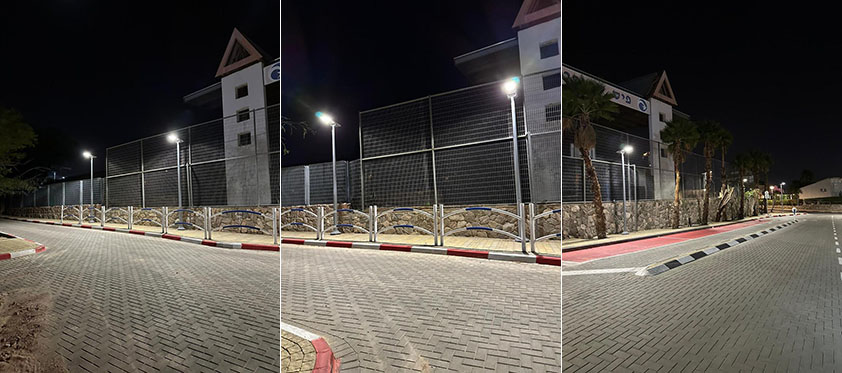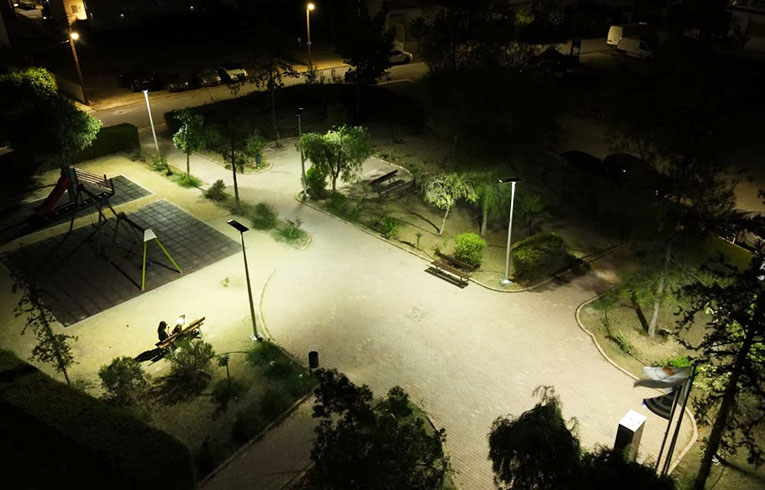Stadium lighting is a type of on-site fixture that is typically used to light large sporting events or other large outdoor events such as concerts. Sports field lighting is typically mounted on poles 40 to 100 feet high with 1-12 lights per pole. With the growing importance of renewable energy sources, sports venues are faced with the challenge of achieving greener, more economical lighting.
In this regard, solar lighting systems are rapidly emerging as one of the best solutions for stadium lighting. This paper will take an in-depth look at why solar lighting for sports stadiums is a viable and sustainable option, and explore the benefits and key elements of implementation.
What are the benefits of LED Solar Stadium Lighting?
LED Solar Stadium Lighting has many significant advantages over traditional HID (High Intensity Discharge) fixtures.
Excellent energy efficiency:
LED fixtures are more efficient at converting energy. Compared to HID fixtures, LEDs produce less heat when generating light. This means that LED solar lighting systems are able to convert electrical energy into visible light more efficiently, resulting in less wasted energy and greater overall energy efficiency.
Advantages of Distributing Light:
LED solar sports field lighting uses multiple point light sources, which means there are multiple individual LED diodes and optics within the fixture. In contrast, traditional HID fixtures typically use a single bulb and reflector. Multiple point light sources allow light to be more evenly distributed across the lighting area, avoiding the spotting or shadowing that can occur in traditional fixtures and providing a more even, comfortable lighting effect.
Colour temperature range and adjustability:
LED technology allows lighting to be adjusted over a wider range of colour temperatures to suit different occasions and needs. The dimmable feature allows the LED solar lighting system to adjust the brightness according to actual needs, providing a more flexible lighting solution.
Long life and low maintenance cost:
LED fixtures typically have a longer lifespan and are more durable than traditional HID fixtures.LED fixtures can last up to tens of thousands of hours, which reduces the frequency of fixture replacements, resulting in lower maintenance and labour costs.

Economic Benefits
The installation of a solar lighting system, although initially costly, can realise significant economic benefits in the long term. Solar systems are relatively inexpensive to operate and can significantly reduce energy bills by lowering electricity demand. In addition, a number of regional governments and agencies offer solar incentives and motivational programmes that provide financial support for solar lighting projects at stadiums.
Continuous Operation and Lighting Effectiveness
One of the advantages of a solar lighting system is its ability to provide lighting in the event of a power outage or emergency. With an energy storage system, excess solar energy absorbed during the day can provide continuous lighting at night or on cloudy or rainy days. At a venue such as a sports ground, it is critical to ensure the continuous operation of the game or event, and solar lighting is the ideal solution to this problem.
Sustainability and the Environment
With society’s growing concern for sustainability, sports fields are no longer just a place for competition and recreation, but also a representation of sustainable development. Solar lighting systems, with their clean, green energy source, provide a highly environmentally conscious lighting solution for sports fields. By going solar, we can significantly reduce our carbon footprint and our reliance on traditional electricity.
Key elements for implementation
Solar Panel Layout: Optimising the layout of the solar panels is key to ensuring the system operates efficiently. Considering that stadiums often have extensive grounds, the right panel layout can maximise solar energy capture.
Intelligent Lighting Control System: Combine advanced lighting control systems such as motion sensors and dimming technology for smarter, energy-efficient lighting. This helps to adjust lighting levels according to actual demand and ensures that sufficient brightness is provided when needed.
Design of Energy Storage Systems: Well-designed energy storage systems to store excess energy collected during the day to supply electricity at night or at times of low energy production.

How can you improve your sports field lighting solution?
Choose a neutral supplier that specialises in LED solar lighting solutions, rather than a company that only offers products. Such a supplier is more likely to be performance-focused and provide you with a solution that best meets your needs.
When speaking with the vendor, be clear about project goals, including budget constraints, ROI criteria, energy savings goals, and lighting performance requirements. This helps the supplier better understand your needs and provide solutions accordingly.
The right partner will want to understand the results you want, not just what specific products they can sell you. Not all LED solar products are created equal. Different manufacturers offer different levels of value for different applications, and by partnering with a company that has the product expertise to recommend a solution that meets your project priorities, you’ll end up with the best results. We’d love to learn more about your upcoming lighting project, so contact us and we’ll be in touch.